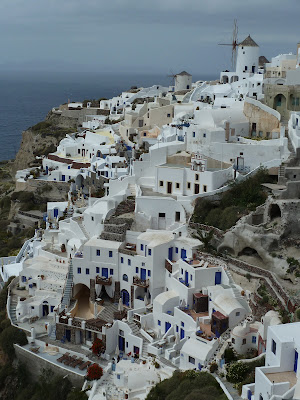Lone Pine at Gallipoli. This place is revered to Australia/New Zealand who celebrate ANZAC (Australian/New Zealand Army Corps) day on April 25th. During WWI, Allied forces attacked at Gallipoli Penninsula and were met with huge resistance by the Turks. For 8 months the battle raged on, almost at a standstill but causalties were heavy on both sides. Allied deaths were over 44,000 and wounded over 86,000. Turkish forces killed are estimated at 87,000 dead/ 167,000 wounded. By the time the Allies evacuated (8 months after landing) a total of over 400,000 dead or wounded. Most of the dead were buried at sea or have no known grave. Their names are engraved on the markers and memorials in the area. It was a very moving and very sobering afternoon spent in Gallipoli.

TROY - The first picture is the replica of the Trojan Horse located at the ancient city of Troia (Troy) That's me looking out the window on the right! Troy was amazing. It used to be a sea port but now is 5 km inland. There are actually 9 different Troys - built on top/around each other over the years. Troy I was built around 3000 BC, Troy VI about 1800 BC and last was Troy IX around 50 BC. As the sea retreated, Troy became less important and was finally abandoned and the Mother Nature reclaimed it. Troy was lost for almost 1800 years. People knew it existed but no one was sure where it had been located.
Others excavated before him but the treasures of Troy were "discovered" by a German named Schliemann in 1870. As a kid, Schliemann read the stories by Homer and dreamed that he would someday find Troy -- which he did. Unfortunately, Schliemann was greedy and he dug a huge trench through the middle of the site, destroying buildings, statues, artifacts as he was only interested in Troy VI and the gold and treasures alluded to by Homer in the Illiad. He found these treasures and smuggled them out of Turkey. He was later forgiven by the Turkish government and returned to excavate Troy and Mycenae in Greece. He died in 1890. The treasures he stole from Troy were still considered missing until 1995 when the Pushkin Museum in Moscow displayed the Trojan Treasures. They had been hiding them for all these years!
Who really owns them is still under debate. Germany says that Schliemann was German so they belong to Germany. Turkey wants them back because they were stolen from Troy located in Turkey. Even Greece wants them back because obviously when they sacked Troy (using the Trojan horse....) they must have missed them but they surely would have taken them at that time, if they'd found them.
This Trojan horse is located in the coastal town and way left there after the filming of the Brad Pitt movie - Troy.

Pergamon - We had the worst tourguide ever but the site was very beautiful and it has a really cool cable car to get you to the top of the site. An ancient Greek city located in Turkey. It was one of the largest cities in the world with a population of 200,000. It had the second best library in all the world containing over 200,000 volumes (Alexandria in Egypt was considered first.) So how did they amass 200,000 volumes of writing? The King (& later his son) wanted to best Alexandria's Library and sent their soldiers out to steal every writing they could find in the land. Egypt caught on and originally papyrus from Egypt was used to write on but then Egypt stopped exporting of papyrus. So in Pergamon they started using parchment made from animal skins. Since papyrus rolled up easily but parchment was not, someone had the great idea to cut it into manageable sized pages and bind them together into.... Books! Books were actually invented in Pergamon.
So what happened to all those books in Pergamon? In 40 BC Romans took control of Egypt and accidentally burned part of Alexandria's library. To make up for the loss, Marc Anthony gave all 200,000 volumes to Cleopatra as a wedding present.
We next visited Ephesus, a beautifully restored archeological site. Nearby, it the house that St. John brought Mary, Mother of Jesus here to live after in Jesus was resurrected. We visited the site which is a small monestary currently. There is much debate whether this is the actual site but if you Google "House of Virgin Mary" you can read the story for yourself. The House of Virgin Mary is a pilgrimage site visited by Christians and Muslims and tourists like me.
Ephesus was amazing! I keep saying that but it was built around 2000 BCand was home to 1/4 million residents. It had fountains to provide running water for drinking and plumbing to take the wastes away. The main road was paved with marble. It had public toilets, a brothel, various churches and a library. So once again, why did this city die? Answer: Malaria. Ephesus was originally a harbor town and earthquakes caused the harbor to silt up, swamps were formed. Mosquitoes and Malaria finished the city off between 600 - 1000 AD.
The main road through the city of Ephesus. The Library of Celsus in the picture below is in the

2 story building towards the upper left of the picture. Below is a close up of the Library. I didn't get a very good picture but it is an optical illusion and the second floor is built smaller than the first floor.
 |
| The Library of Celsus |
From the top of The Grand Theatre (above

) and from the stage of the Grand Theatre (below). It had a 25,000 spectator capacity.








































